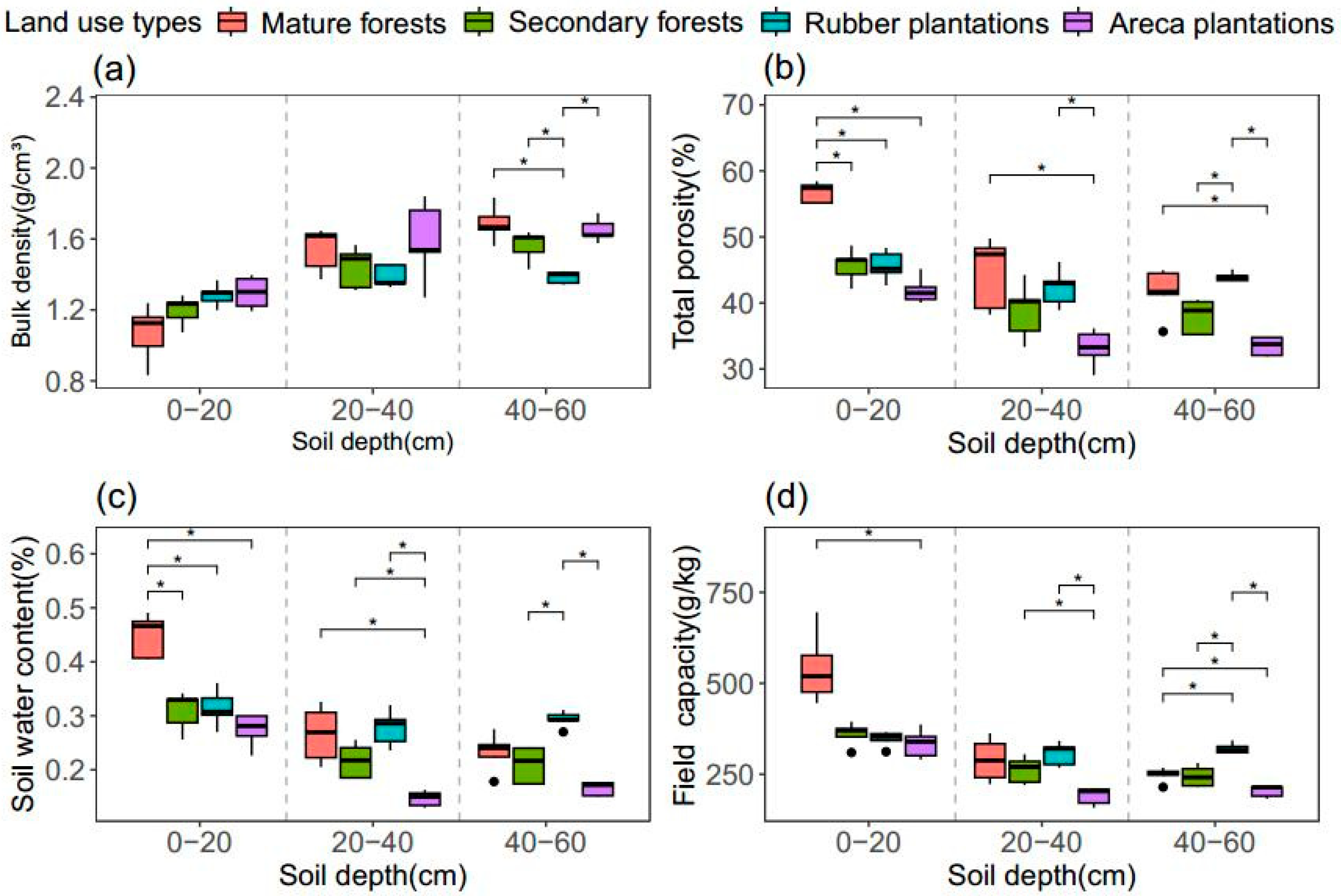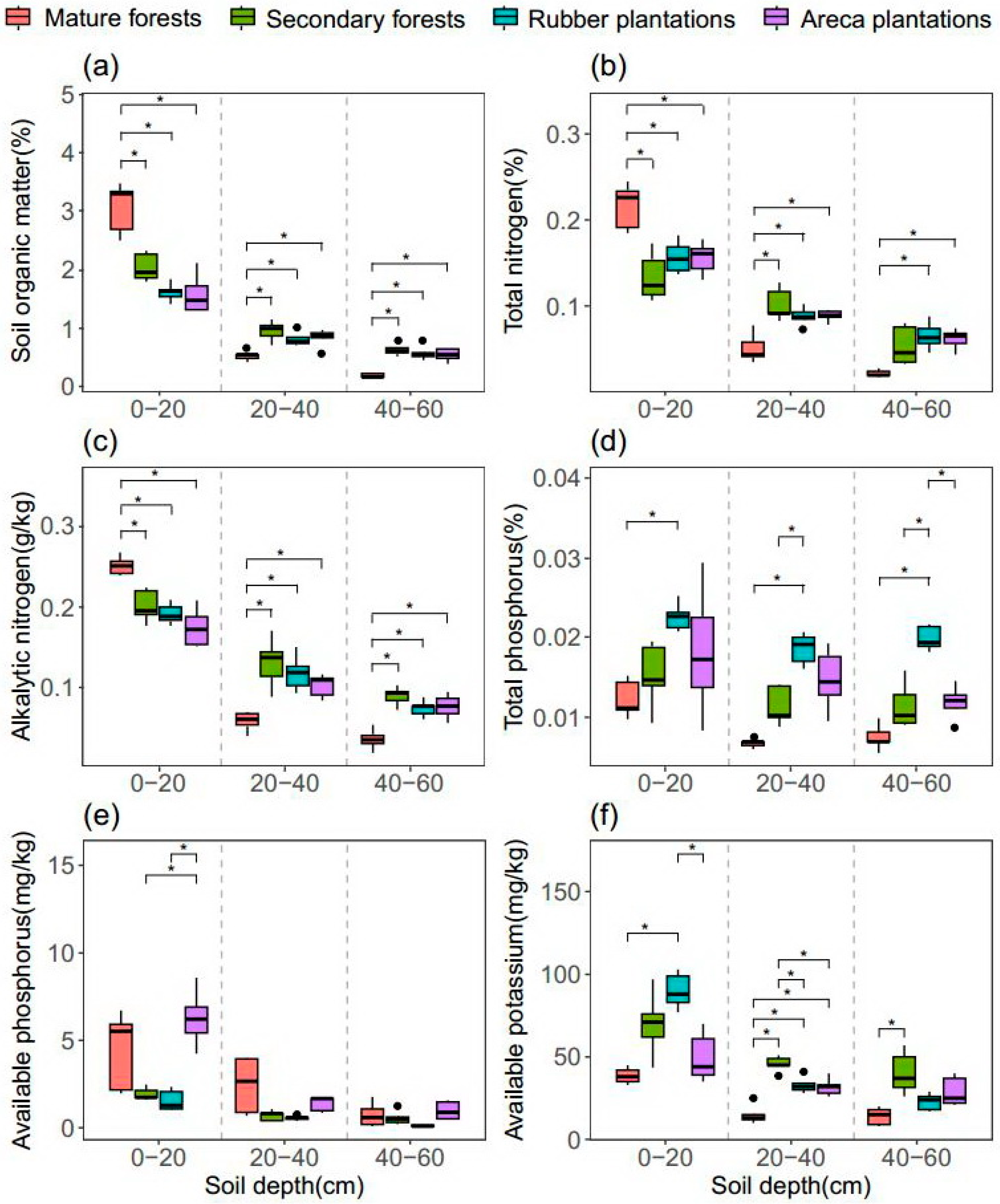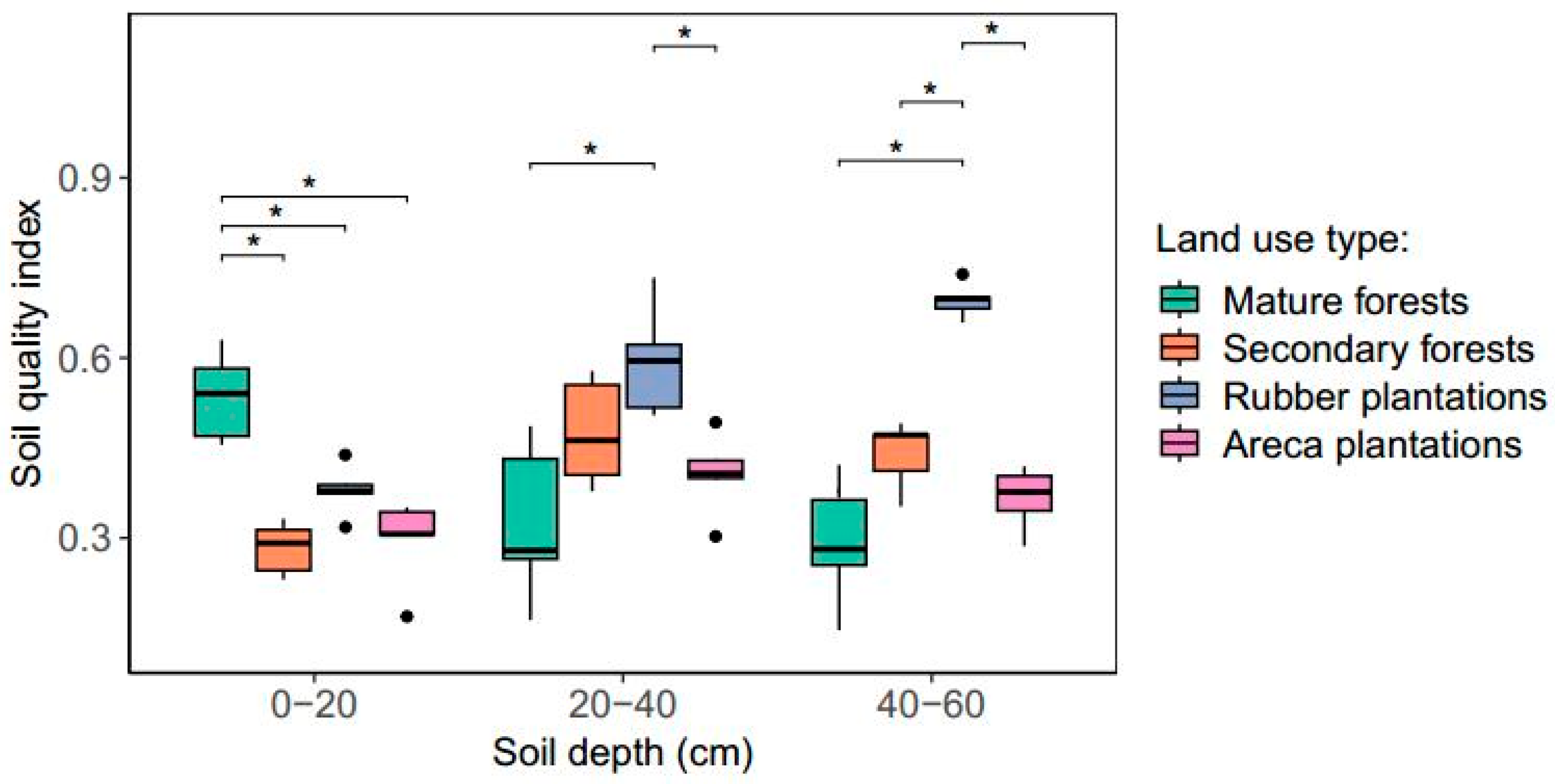Response of Depth-Stratified Soil Quality to Land-Use Conversion and Its Limiting Factors in Tropical Ecosystems
Abstract
1. Introduction
2. Materials and Methods
2.1. Study Area
2.2. Soil Sampling and Analysis
2.3. Soil Quality Assessment
2.4. Diagnostic Model for Soil Quality Limiting Factors
2.5. Statistical Analysis
3. Results
3.1. Variations in Soil Properties
3.2. Variations in Soil Quality
3.3. Characteristics of Soil Limiting Factors
4. Discussion
5. Conclusions
Supplementary Materials
Author Contributions
Funding
Data Availability Statement
Acknowledgments
Conflicts of Interest
References
- Biedemariam, M.; Birhane, E.; Demissie, B.; Tadesse, T.; Gebresamuel, G.; Habtu, S. Ecosystem Service Values as Related to Land Use and Land Cover Changes in Ethiopia: A Review. Land 2022, 11, 2212. [Google Scholar] [CrossRef]
- Fathy, H.; Heydari, M.; Fathizad, H.; Hosseinzadeh, J.; Najafifar, A.; Mousavi, S.R.; Jafarzadeh, A.; Heung, B. From forest to farmland: Tracking time series variations in soil quality in semiarid oak forest. Geoderma Reg. 2025, 42, e974. [Google Scholar] [CrossRef]
- Yang, Q.; Jaworski, C.C.; Wen, Z.; Desneux, N.; Ouyang, F.; Dai, X.; Wang, L.; Jia, J.; Zheng, H. Crop heterogeneity may not enhance biological control of rice pests in landscapes rich in semi-natural habitats. Agric. Ecosyst. Environ. 2025, 379, 109354. [Google Scholar] [CrossRef]
- Ren, Q.; Qiang, F.; Liu, G.; Liu, C.; Ai, N. Response of soil quality to ecosystems after revegetation in a coal mine reclamation area. Catena 2025, 257, 109038. [Google Scholar] [CrossRef]
- Selmy, S.A.H.; Abd Al-Aziz, S.H.A.; Jiménez-Ballesta, R.; Jesús García-Navarro, F.; Fadl, M.E. Soil Quality Assessment Using Multivariate Approaches: A Case Study of the Dakhla Oasis Arid Lands. Land 2021, 10, 1074. [Google Scholar] [CrossRef]
- Kahsay, A.; Haile, M.; Gebresamuel, G.; Mohammed, M.; Christopher Okolo, C. Assessing land use type impacts on soil quality: Application of multivariate statistical and expert opinion-followed indicator screening approaches. Catena 2023, 231, 107351. [Google Scholar] [CrossRef]
- Shuite, Z.; Demessie, A.; Abebe, T. Land use effect on soil quality and its implication to soil carbon storage in Aleta Chuko, Ethiopia. Geoderma Reg. 2025, 40, e917. [Google Scholar] [CrossRef]
- Chanu, L.J.; Purakayastha, T.J.; Bhaduri, D.; Ali, M.F.; Shivay, Y.S.; Saren, S.; Kumar, V.; Alhomrani, M.; Alamri, A.S. Assessment of soil biological quality under long-term rice-wheat cropping system: Effect of continuous vs. residual organic nutrient inputs. Soil. Tillage Res. 2025, 254, 106725. [Google Scholar] [CrossRef]
- Ishaq, H.K.; Grilli, E.; D’Ascoli, R.; Mastrocicco, M.; Rutigliano, A.F.; Marzaioli, R.; Strumia, S.; Coppola, E.; Malrieu, I.; Silva, F.; et al. Soil quality under rotational and conventional grazing in Mediterranean areas at desertification risk. J. Environ. Manag. 2025, 373, 123822. [Google Scholar] [CrossRef]
- Li, S.; Luo, D.; Wang, J.; Wei, Y.; Yuan, Z. Assessing soil quality in association with frozen ground in the source areas of the Yangtze and Yellow Rivers, Qinghai-Tibet Plateau. Geoderma 2025, 456, 117264. [Google Scholar] [CrossRef]
- Negiş, H.; Şeker, C.; Gümüş, O.; Erci, V. Establishment of a minimum dataset and soil quality assessment for multiple reclaimed areas on a wind-eroded region. Catena 2023, 229, 107208. [Google Scholar] [CrossRef]
- Tang, Z.; Zhang, W.; Chen, J.; Zhang, Y. Soil quality assessment and its response to water flow connectivity in different vegetation restoration types, eastern China. Catena 2024, 247, 108477. [Google Scholar] [CrossRef]
- Gan, F.; Shi, H.; Yan, Y.; Pu, J.; Dai, Q.; Gou, J.; Fan, Y. Soil quality assessment of karst trough valley under different bedrock strata dip and land-use types, based on a minimum data set. Catena 2024, 241, 108048. [Google Scholar] [CrossRef]
- Liu, Y.; Wang, P.; Yu, T.; Zang, H.; Zeng, Z.; Yang, Y. Manure replacement of chemical fertilizers can improve soil quality in the wheat-maize system. Appl. Soil Ecol. 2024, 200, 105453. [Google Scholar] [CrossRef]
- Peiyao, X.; Yuying, H.; Yaojun, L.; Chuxiong, D.; Wenqing, L.; Guangye, Z.; Taoxi, L.; Yichun, M.; Ming, L.; Yu, L.; et al. Mechanisms of land use change effects on soil quality in ancient terraces based on the minimum data set approach. Catena 2025, 254, 108990. [Google Scholar] [CrossRef]
- Feng, W.; Ai, J.; Sánchez-Rodríguez, A.R.; Li, S.; Zhang, W.; Yang, H.; Apostolakis, A.; Muenter, C.; Li, F.; Dippold, M.A.; et al. Depth-dependent patterns in soil organic C, enzymatic stochiometric ratio, and soil quality under conventional tillage and reduced tillage after 55-years. Agric. Ecosyst. Environ. 2025, 385, 109584. [Google Scholar] [CrossRef]
- Fasano, M.C.; Bich, G.A.; Castrillo, M.L.; Zapata, P.D. Assessing soil quality, the role of indigenous knowledge and biological indicators in novelle soil quality research. Environ. Sustain. Indic. 2025, 26, 100707. [Google Scholar] [CrossRef]
- Allek, A.; Viany Prieto, P.; Korys, K.A.; Rodrigues, A.F.; Latawiec, A.E.; Crouzeilles, R. How does forest restoration affect the recovery of soil quality? A global meta-analysis for tropical and temperate regions. Restor. Ecol. 2023, 31, e13747. [Google Scholar] [CrossRef]
- Macheroum, A.; Sayada, N.; Chenchouni, H. Restoration of soil quality and improvement of physicochemical properties through grazing exclusion in arid and semi-arid rangelands. Catena 2025, 249, 108646. [Google Scholar] [CrossRef]
- Belay, A.; Assen, M.; Abegaz, A. Soil quality dynamics in response to land-use management types and slope positions in northeastern highlands of Ethiopia. Environ. Sustain. Indic. 2025, 26, 100641. [Google Scholar] [CrossRef]
- Zheng, H.; Wang, L.; Peng, W.; Zhang, C.; Li, C.; Robinson, B.E.; Wu, X.; Kong, L.; Li, R.; Xiao, Y.; et al. Realizing the values of natural capital for inclusive, sustainable development: Informing China’s new ecological development strategy. Proc. Natl. Acad. Sci. USA 2019, 116, 8623–8628. [Google Scholar] [CrossRef]
- Wen, Z.; Zheng, H.; Zhao, H.; Ouyang, Z. The mediatory roles of species diversity and tree height diversity: Linking the impact of land-use intensity to soil erosion. Land Degrad. Dev. 2021, 32, 1127–1134. [Google Scholar] [CrossRef]
- Wen, Z.; Zhao, H.; Liu, L.; Ouyang, Z.Y.; Zheng, H.; Mi, H.X.; Li, Y.M. Effects of land use changes on soil water conservation in Hainan Island, China. J. Appl. Ecol. 2017, 28, 4025–4033. [Google Scholar]
- Zheng, H.; Ouyang, Z.Y.; Wang, X.K.; Miao, H.; Zhao, T.Q.; Peng, T.B. How different reforestation approaches affect red soil properties in southern China. Land Degrad. Dev. 2005, 16, 387–396. [Google Scholar] [CrossRef]
- Chen, C.; Yang, F.; Zhao, L.; Yao, H.; Wang, J.; Liu, H. Influences of different land use types on soil characteristics and availability in Karst area, Guizhou Province. Acta Agrestia Sin. 2014, 22, 1007–1013. [Google Scholar]
- Si, F.; Chen, B.; Wang, B.; Li, W.; Zhu, C.; Fu, J.; Yu, B.; Xu, G. Soil Quality Assessment and Influencing Factors of Different Land Use Types in Red Bed Desertification Regions: A Case Study of Nanxiong, China. Land 2024, 13, 1265. [Google Scholar] [CrossRef]
- Abuzaid, A.S.; Mazrou, Y.S.A.; El Baroudy, A.A.; Ding, Z.; Shokr, M.S. Multi-Indicator and Geospatial Based Approaches for Assessing Variation of Land Quality in Arid Agroecosystems. Sustainability 2022, 14, 5840. [Google Scholar] [CrossRef]
- Wen, Z.; Zheng, H.; Li, R.; Yang, Y.; Ouyang, Z. Plant functional groups modulate the effects of landscape diversity on natural predators. Agric. Ecosyst. Environ. 2025, 381, 109415. [Google Scholar] [CrossRef]
- Wickham, H.; Francois, R. dplyr: A Grammar of Data Manipulation. R Package Version 0.4.3. 2015. Available online: http://CRAN.R-project.org/package=dplyr (accessed on 9 May 2025).
- Kassambara, A. rstatix: Pipe-Friendly Framework for Basic Statistical Tests; CRAN: Contributed Packages; Comprehensive R Archive Network: Online, 2019. [Google Scholar]
- Harrell, F.E., Jr.; Harrell, M.F.E., Jr. Package ’Hmisc’; CRAN2018; Comprehensive R Archive Network: Online, 2019; pp. 235–236. [Google Scholar]
- Wickham, H. ggplot2. Wiley Interdiscip. Rev. Comput. Stat. 2011, 3, 180–185. [Google Scholar] [CrossRef]
- Wei, T.; Simko, V.; Levy, M.; Xie, Y.; Jin, Y.; Zemla, J. Package’corrplot’. Statistician 2017, 56, e24. [Google Scholar]
- Chen, C.; Liu, W.; Wu, J.; Jiang, X.; Zhu, X. Can intercropping with the cash crop help improve the soil physico-chemical properties of rubber plantations? Geoderma 2019, 335, 149–160. [Google Scholar] [CrossRef]
- Zhu, X.; Liu, W.; Jiang, X.J.; Wang, P.; Li, W. Effects of land-use changes on runoff and sediment yield: Implications for soil conservation and forest management in Xishuangbanna, Southwest China. Land. Degrad. Dev. 2018, 29, 2962–2974. [Google Scholar] [CrossRef]
- Wen, Z.; Zheng, H.; Smith, J.R.; Ouyang, Z. Plant functional diversity mediates indirect effects of land-use intensity on soil water conservation in the dry season of tropical areas. Forest Ecol. Manag. 2021, 480, 118646. [Google Scholar] [CrossRef]
- Liu, W.; Luo, Q.; Lu, H.; Wu, J.; Duan, W. The effect of litter layer on controlling surface runoff and erosion in rubber plantations on tropical mountain slopes, SW China. Catena 2017, 149, 167–175. [Google Scholar] [CrossRef]
- Sayer, E.J.; Baxendale, C.; Birkett, A.J.; Bréchet, L.M.; Castro, B.; Kerdraon-Byrne, D.; Lopez-Sangil, L.; Rodtassana, C.; Sveriges, L. Altered litter inputs modify carbon and nitrogen storage in soil organic matter in a lowland tropical forest. Biogeochemistry 2021, 156, 115–130. [Google Scholar] [CrossRef]
- Zhu, X.; Chen, C.; Wu, J.; Yang, J.; Zhang, W.; Zou, X.; Liu, W.; Jiang, X. Can intercrops improve soil water infiltrability and preferential flow in rubber-based agroforestry system? Soil. Tillage Res. 2019, 191, 327–339. [Google Scholar] [CrossRef]
- Wu, J.; Zeng, H.; Zhao, F.; Chen, C.; Liu, W.; Yang, B.; Zhang, W. Recognizing the role of plant species composition in the modification of soil nutrients and water in rubber agroforestry systems. Sci. Total Environ. 2020, 723, 138042. [Google Scholar] [CrossRef]
- Tambone, F.; Masseroli, A.; Beccarelli, P.; Breno, L.; Zuccolo, M.; Borgonovo, G.; Mazzini, S.; Golinelli, A.; Scaglia, B. Characterization of Litter and Topsoil Under Different Vegetation Cover by Using a Chemometric Approach. Forests 2025, 16, 1349. [Google Scholar] [CrossRef]
- Jiba, W.; Manyevere, A.; Mashamaite, C.V. The Impact of Ecological Restoration on Soil Quality in Humid Region Forest Habitats: A Systematic Review. Forests 2024, 15, 1941. [Google Scholar] [CrossRef]
- Zhu, X.; Liu, W.; Chen, J.; Bruijnzeel, L.A.; Mao, Z.; Yang, X.; Cardinael, R.; Meng, F.; Sidle, R.C.; Seitz, S.; et al. Reductions in water, soil and nutrient losses and pesticide pollution in agroforestry practices: A review of evidence and processes. Plant Soil. 2020, 453, 45–86. [Google Scholar] [CrossRef]
- Thorup-Kristensen, K. Effect of deep and shallow root systems on the dynamics of soil inorganic N during 3-year crop rotations. Plant Soil. 2006, 288, 233–248. [Google Scholar] [CrossRef]
- Yang, B.; Meng, X.; Singh, A.K.; Wang, P.; Song, L.; Zakari, S.; Liu, W. Intercrops improve surface water availability in rubber-based agroforestry systems. Agric. Ecosyst. Environ. 2020, 298, 106937. [Google Scholar] [CrossRef]
- Zheng, X.; Yuan, J.; Zhang, T.; Hao, F.; Jose, S.; Zhang, S. Soil Degradation and the Decline of Available Nitrogen and Phosphorus in Soils of the Main Forest Types in the Qinling Mountains of China. Forests 2017, 8, 460. [Google Scholar] [CrossRef]
- Zhang, P.; Lü, X.; Li, M.; Wu, T.; Jin, G. N limitation increases along a temperate forest succession: Evidences from leaf stoichiometry and nutrient resorption. J. Plant Ecol. 2022, 15, 1021–1035. [Google Scholar] [CrossRef]
- Valdespino, P.; Romualdo, R.; Cadenazzi, L.; Campo, J. Phosphorus cycling in primary and secondary seasonally dry tropical forests in Mexico. Ann. Forest Sci. 2009, 66, 107. [Google Scholar] [CrossRef]
- Hanyabui, E.; Obeng Apori, S.; Agyei Frimpong, K.; Atiah, K.; Abindaw, T.; Ali, M.; Yeboah Asiamah, J.; Byalebeka, J. Phosphorus sorption in tropical soils. AIMS Agric. Food 2020, 5, 599–616. [Google Scholar] [CrossRef]
- Wen, Z.; Wu, J.; Yang, Y.; Li, R.; Ouyang, Z.; Zheng, H. Implementing intercropping maintains soil water balance while enhancing multiple ecosystem services. Catena 2022, 217, 106426. [Google Scholar] [CrossRef]
- Yang, B.; Meng, X.; Zhu, X.; Zakari, S.; Singh, A.K.; Bibi, F.; Mei, N.; Song, L.; Liu, W. Coffee performs better than amomum as a candidate in the rubber agroforestry system: Insights from water relations. Agr. Water Manag. 2021, 244, 106593. [Google Scholar] [CrossRef]
- Mori, T.; Lu, X.; Aoyagi, R.; Mo, J. Reconsidering the phosphorus limitation of soil microbial activity in tropical forests. Funct. Ecol. 2018, 32, 1145–1154. [Google Scholar] [CrossRef]




Disclaimer/Publisher’s Note: The statements, opinions and data contained in all publications are solely those of the individual author(s) and contributor(s) and not of MDPI and/or the editor(s). MDPI and/or the editor(s) disclaim responsibility for any injury to people or property resulting from any ideas, methods, instructions or products referred to in the content. |
© 2025 by the authors. Licensee MDPI, Basel, Switzerland. This article is an open access article distributed under the terms and conditions of the Creative Commons Attribution (CC BY) license (https://creativecommons.org/licenses/by/4.0/).
Share and Cite
Li, Y.; Zhang, T.; Wang, S. Response of Depth-Stratified Soil Quality to Land-Use Conversion and Its Limiting Factors in Tropical Ecosystems. Land 2025, 14, 2010. https://doi.org/10.3390/land14102010
Li Y, Zhang T, Wang S. Response of Depth-Stratified Soil Quality to Land-Use Conversion and Its Limiting Factors in Tropical Ecosystems. Land. 2025; 14(10):2010. https://doi.org/10.3390/land14102010
Chicago/Turabian StyleLi, Yanmin, Tianqi Zhang, and Shihang Wang. 2025. "Response of Depth-Stratified Soil Quality to Land-Use Conversion and Its Limiting Factors in Tropical Ecosystems" Land 14, no. 10: 2010. https://doi.org/10.3390/land14102010
APA StyleLi, Y., Zhang, T., & Wang, S. (2025). Response of Depth-Stratified Soil Quality to Land-Use Conversion and Its Limiting Factors in Tropical Ecosystems. Land, 14(10), 2010. https://doi.org/10.3390/land14102010





